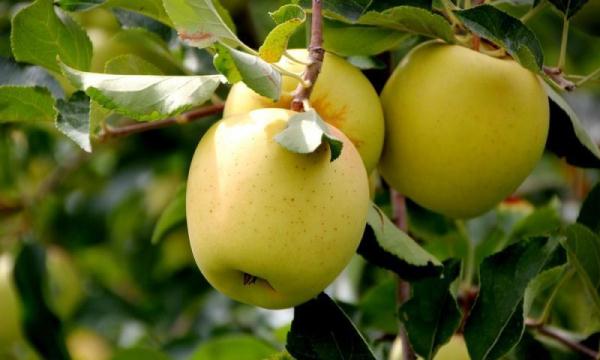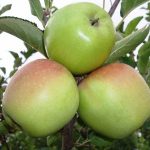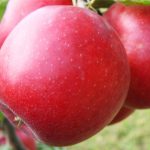The most popular among fruits in our country are apples; due to its taste and great content of beneficial to the bodyin, as well as the presence of various varieties (both summer and winter). One of the favorite for many winter varieties is the Golden Golden Apple Tree. About her and tell in our article.
Table of contents
Description of the variety of apples Golden
The variety was bred randomly when the Grimes Golden and Golden Reinette varieties were inadvertently crossed in 1905. This happened in the garden of the farmer Mullins (Clay district in West Virginia), so the original apple tree was called the Yellow Sapling of Mullins. Since 1914 after the tree was sold by the breeder and the rights to distribute to the Nurseries and Gardens of the Stark Brothers, they started selling it as an addition to the variety Red Delicious.
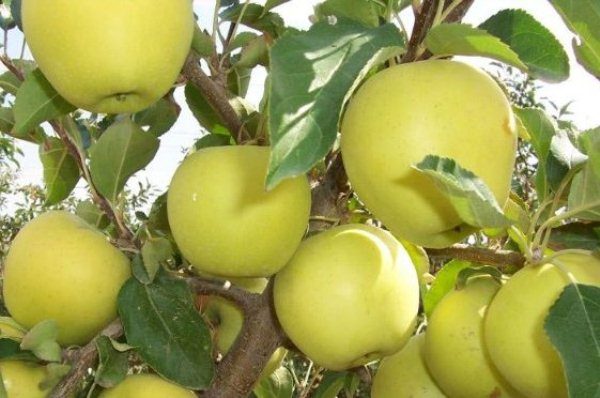
Today it is the most popular variety of apples, not only in the United States, but also in other European countries, where entire plantations of trees have been created, allowing to grow these fruits on an industrial scale.
Advantages and disadvantages
Like any plant, apple varieties of this variety have a number of advantages and disadvantages. The first characteristic may include such indicators as:
- Pretty tall frost and drought tolerance;
- High yield and productivity (with proper care more than 1c from the tree);
- Skoroplodnost - it is possible to harvest the first crops from 2-3 year old trees;
- The full ratio of quality and taste indicators fruits with international standards, as a result, their widespread use in the food industry, cooking and preservation;
- Long-term storage capacity under the right conditions, otherwise the fruits will begin to fade;
- High stability to the effects of a large number of various pests and diseases;
- Frequent use in crossing with other varieties for hybrids. Examples of selections are such hybrid varieties as Priam, Freiberg, Korea, etc.
- Korea
- Priam
The second is characterized by the following indicators:
- Propensity to be affected by diseases such as powdery mildew and scab;
- With a large crop overload observed size reduction in fruits;
- Availability high yield frequency;
- Demanding care soil fertility;
- Lower yields during the "aging" of the tree.
Characteristics of trees and fruits
Tree description
With regards to the trees themselves, they belong to the category of medium-sized plants with a crown varying in shape, depending on their age. So, young apple trees are cone-shaped, and fruit-bearing ones are most rounded with interlaced branches and foliage.. A bountiful harvest can cause branches to sag, which makes trees look like willow.The shoots are distinguished by their brownish color with green veins from the color of the trunk, which has a dark gray color. They are not very thick, slightly pubescent and weakly stiff and have oval lentils, rather large and densely scattered.

Golden has wide oval leaves, with rounded bases and slightly elongated tips.. They are smooth to the touch with edges, having notches, slightly pubescent, have long petioles and lanceolate stipules. The color of the foliage is bright green.
As stated earlier first harvests can be obtained as early as 2-3 years after budding. During the first few years, abundant yields are guaranteed, then they will depend on the climatic conditions, the quality of care and the use of fertilizers.
Fruit Description
They are characterized by such indicators as:
- The size - apples are both medium and large, depending on weather conditions (for example, Kuban often reach up to 170g.);
- The form - round-conical fruits, turned with a dense, dry skin that, under favorable growing conditions, becomes slightly rough;
- Colour - from golden light green to yellow, in places a slightly pinkish hue may appear due to exposure to sunlight;
- Taste - sweet and gentle;
- Structure - has a closed cup with openings at the bottom of the sepals. Fruits are distinguished by long stems, of medium thickness and prominent above a deep funnel. The apples are equipped with a narrow, deep and even saucer and a small axial cavity that does not communicate with the seed chambers. The flesh is very juicy, dense, greenish hue, which eventually becomes creamy.
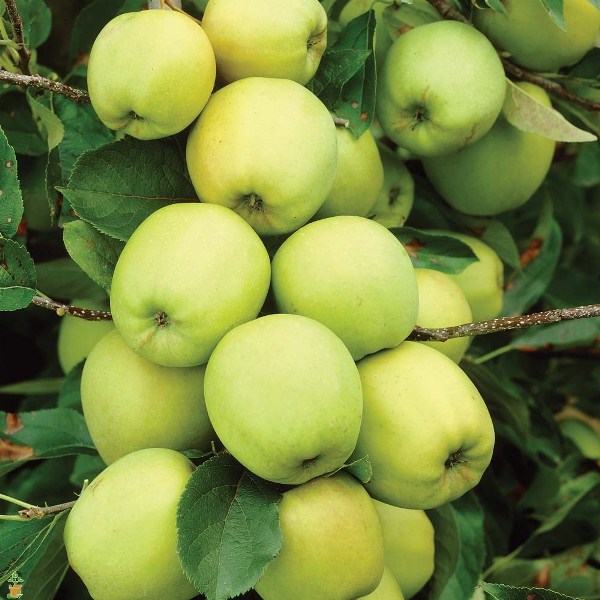
Harvest recommended in late September. Fruits are able to be stored until mid-spring, subject to proper conditions. For example, in low humidity rooms, apples will begin to wither.
Although experiments were conducted by breeders, such Golden apples are grown in the southern regions of Russia, as strong frosts can freeze the plant even with proper insulation. However, it is possible to meet the apple trees of this variety in the gardens of the Moscow region and the middle zone of our country.
Landing secrets
Planting trees is carried out using semi-dwarf rootstock according to the scheme 4 * 4m. Pre-determine the indicators of the groundwater level, as the recommended depth of their occurrence should be a mark of 2.5 m. In the southern regions, the best time for landing is October, for the northern - mid-April. The best soil for apple trees is chernozem.
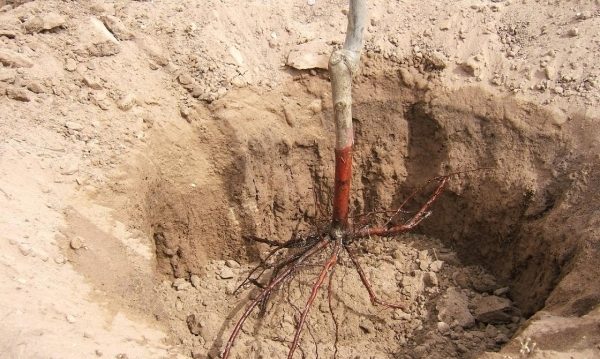
The process begins with the preparation of the landing pitwhose size must be at least 1 * 1m and a depth of 0.7m. It is dug up 1 month before planting to ensure high-quality precipitation of the earth and fertilized with superphosphate, ash and potassium. In the middle of the pit, a stake is set, protruding 0.4m above its surface. It should be noted that the lower part of the stake is burned with fire in order to prevent rotting.
After the allotted time, a hole is made in the pit, to the bottom of which black earth is poured. Further, a sapling is planted so that the peg is on the south side and the root neck of the trunk of the tree rises to a height of 5 cm above the ground. So that it does not settle down with the soil, it is tied to a peg. Then the landing site is plentifully watered (3-4 buckets of water) and covered with earth.
Apple care
Pruning
The main care for plants is pruning, which is produced every year. This provides earlier fruiting and high yields, longer service life, protection from frostbite. The time of the process alternate, that is, first it is carried out in early spring before the formation of buds, then in the fall. To limit the growth of trees upwards and the active formation of lateral shoots, a vertical shoot is compulsorily trimmed.. Also, the growth is trimmed annually, and 1/3 of their length is removed from it. It stimulates the formation and growth of fruit branches.
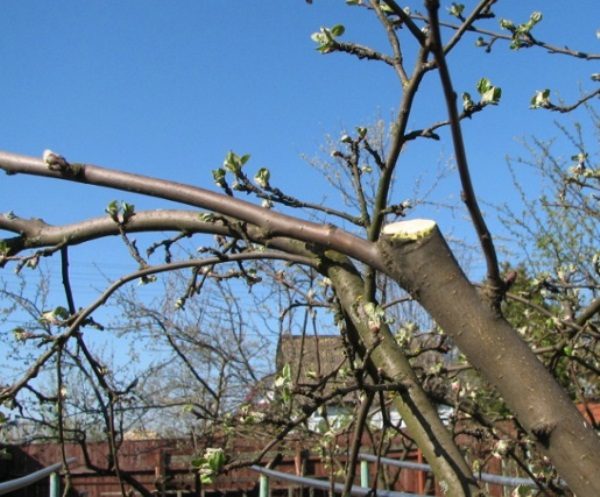
The next step in the care process is to thinning of ovaries and fruitsnecessary to prevent underdeveloped apples with low taste. To do this, during the formation of ovaries or fruits, the one in the middle is removed, as well as apples with some defects. The intervals from one to the other beam must be not less than 0.1 m.
Watering
As for watering, he in the first year is needed 3-4 times per summer, as excessive wetting can lead to cracking of fruits. Water consumption - 3-4 buckets on the tree. After wetting the soil cover is mulched with humus. In a dry summer, trees are watered until the buds open, 20 days after the end of flowering and the same period before harvest.
Top dressing
For the proper development of apple trees and obtaining a good harvest, fertilization is required. So, nitrogenous substances affect the growth, pollination of flowers, the formation of ovaries, phosphate - on the formation of fruit buds and the color of the fruit, potash - the growth of young shoots, etc. The ideal option for feeding is the alternation of organic and mineralfertilizer.
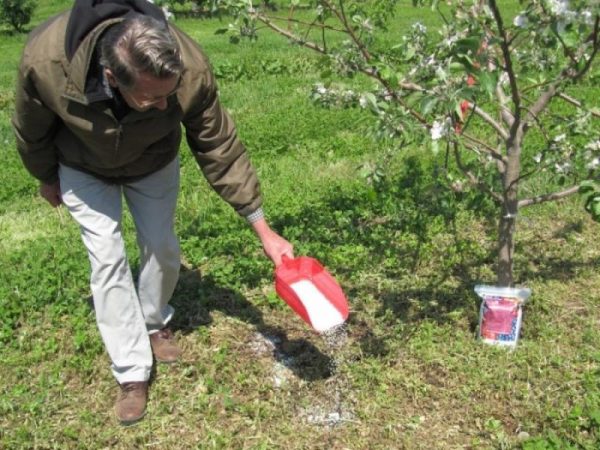
The most popular organic fertilizer is manure.which is made every year in the autumn period. Nitrogen substances are used 2 times a year - in early spring and in the first half of the growing season, phosphate and potash are introduced during the same periods, but not directly, but by sealing them into excavated grooves around the trunk circle and having a depth of up to 0.4m.
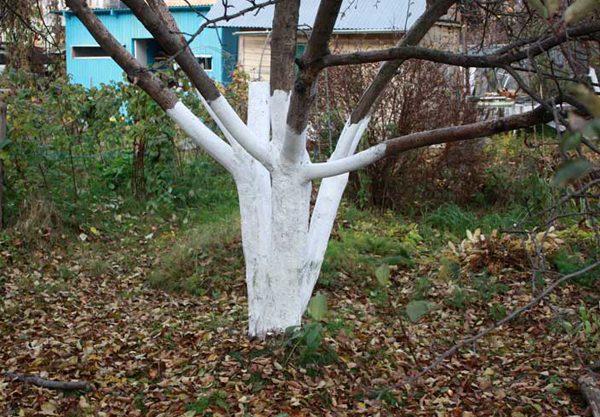
Before frost, the trunk circle is mulched with the help of humus, peat and compost. Apple trees are subjected to hilling and strapping with spruce or cane, and they are also whitened with a solution of chalk or lime.
Diseases and pests
Golden, like other varieties of apples, is subject to various diseases, but most commonly found on them are scab and powdery mildew. For destruction use sprays such preparations as Skor, Topaz, Ridomil-Gold.
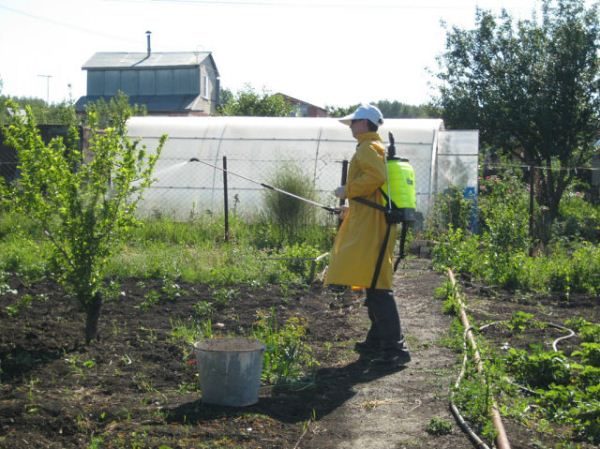
Apples suffer from apple buds and aphids, and from moths and leaflets. They are also controlled by spraying with chemicals..
In summing up to the above, I wanted to say that Golden stands out among other apple varieties with its beautiful appearance and excellent taste, so we recommend having this variety in any garden.
